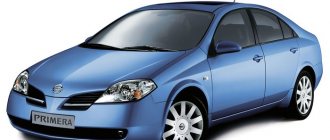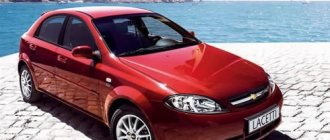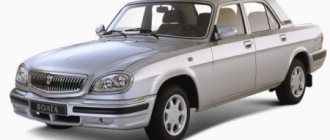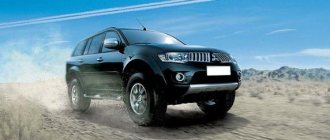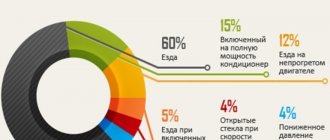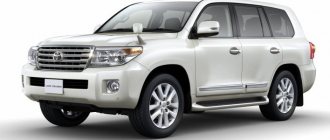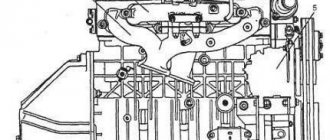When choosing a car, be it new or used, information about the strengths and weaknesses of various models is analyzed. Next comes the moment when a preliminary analysis has been carried out, and then an in-depth study of the car you like begins.
In our case, this car is the Honda Fit, which completely suits us with its technical characteristics. But in addition to the basic parameters, information about the fuel consumption of this model will be interesting. After all, this is the largest cost item during operation.
Fuel consumption per 100 km Honda Fit
Fuel consumption depends on many factors, such as driving style, operating conditions, engine wear, as well as other components and assemblies. Also, fuel consumption will be different due to different modifications of the installed power plants.
Let's consider the consumption under various operating modes on the Honda Fit model. We will summarize all official data in a table with characteristics.
This model began production in 2001, having replaced several generations and gone through several restylings, it remains popular to this day:
- Honda Fit (Generation 4 – 2019-present);
- Honda Fit (Generation 3 – 2013-2017; Generation 3 Restyling – 2017-2019);
- Honda Fit (Generation 2 – 2007-2013);
- Honda Fit (Generation 1 – 2001-2007).
Along the highway
In practice, the highway driving mode is the most economical driving option for the Honda Fit. This is also reflected in the passport characteristics declared by the manufacturer for this car.
But it is worth considering that fuel consumption according to the passport will differ from consumption in real conditions. Factory tests create ideal conditions and maintain optimal engine speed and rpm.
In the city
Driving around the city in a Honda Fit is the most expensive mode in terms of fuel consumption. And real data may differ very much from the reference data set by the manufacturer.
Driving a car with sudden accelerations, frequent idle times at traffic lights, or in hours-long traffic jams do not contribute to fuel economy. As, indeed, are frequent trips over short distances made during the day.
If you exclude these factors, and also stick to a calm ride with smooth acceleration and braking. It is quite possible to meet the figures stated by the manufacturer, shown in the table below.
Medium (mixed cycle)
The average fuel consumption of the Honda Fit implies driving a car in urban and suburban cycles. This is what people pay attention to when choosing a vehicle, as well as when taking into account expenses.
But the mixed cycle, like those given above, in real conditions may differ from the reference ones indicated by the manufacturer. Therefore, you should not rely on them fully.
Usually, experienced drivers, in order to get more realistic figures, advise adding 10-15% to the consumption indicated in the passport specifications.
First generation Honda Fit 2001- 2007 GD1, 2, 3, 4
The first generation Honda Fit was released in 2001. In the mid-90s, Honda was losing in the small car market, automakers produced strong cars that were superior to Honda's Logo and Capa models.
To beat the competition, Honda needed to release a car that was superior in every aspect. The company puts everything on the line and releases a car built from scratch called the Honda Fit.
The model had the effect of a hydrogen bomb on the car market; during its debut, everyone was talking about it, even those who were not interested in cars, it was an undoubted success.
The Honda Fit is built on a new platform; an L13A engine, a new generation CVT and chassis were built for it. The appearance of the Honda created a sensation, everyone liked the car, the Fit looked more expensive than it actually costs. The extensive color range made the car even more attractive; consumers chose from 10 different colors.
The interior of the Honda Fit amazed many, it was much larger than it seemed from the outside, the front and rear passengers felt comfortable, and the trunk allowed it to accommodate a lot; with the rear seats folded down, you could transport a bicycle or a surfboard.
Interior of Honda Fit Hybrid, RS version
Honda's driver's seat in this class is standard; the seats with lateral support can be adjusted to suit any person. The dashboard looks modern and rich, and the switches and buttons are easy to use.
Technical part
The L13A engine is surprising in that it has 8 ignition coils and 8 spark plugs.
Initially, a front-wheel drive version was offered, but to maintain demand, the company is releasing the Honda Fit with all-wheel drive.
Following the 4WD version comes the larger L15A engine with 110 horsepower and 143 Hm of torque. The engine had 4 iridium spark plugs instead of 8 conventional ones and a VTEC valve timing system.
The chassis of the Honda Fit is unpretentious and reliable, the model handles well. There is a MacPherson strut at the front and a beam at the rear.
The first generation was produced from 2001 to 2007; throughout its life cycle the car was popular; many subsequent Honda cars were produced on the basis of the Fit.
After a successful release in Japan, the model conquered Europe and America under the name Honda Jazz.
It is worth saying that the car was twice awarded the “Best Car of the Year in Japan” award, and once “Car of the Decade in Japan”.
Specifications
Date of production: 2001-2006 Country of manufacture: Japan Body: hatchback Body brand: GD Number of doors: 5 Number of seats: 5 Length: 3830 Width: 1675 Height: 1525 Wheelbase: 2450 Ground clearance: 150 Minimum turning radius: 4.7 meters Tire size: 175/65R14 Drive: front and 4WD • Transmission: continuously variable transmission with 7 driving modes Front brakes: ventilated disc Rear brakes: drum Fuel consumption: 4.3 liters per 100 km/h Weight: 1000 kilograms Fuel tank capacity : 42 liters
Maintenance Tips
Price
Second generation Honda Fit 2007-2013 GE 6/7/8/9
First, engineers took on the handling; in the previous model, the suspension was a bit stiff. In the new generation, the chassis has been improved and handling has become excellent. The suspension remains the same, MacPherson strut in front, beam in the rear, but its settings have changed. The car was tested at the Hokkaido race track (Japanese Nürburgring), where the entire chassis was finalized.
Externally, the Honda Fit began to look fresher, the designers did not completely change the exterior, they updated and improved the old one, they did a great job.
The engines of the Honda Fit remain the same, these are the reliable L13A and L15A, but there are some improvements. Both units acquired a valve timing system - I-VTEC, which increased power and reduced fuel consumption. The 1.3 liter engine acquired 4 iridium spark plugs, instead of the usual 8. The power of this engine has increased to 99 horsepower and 126 Hm of torque.
The power of the 1.5 liter engine has increased to 120 horsepower and 145 Hm of torque. The engines are offered with 3 transmission options, regular models with 1.3 liter units are equipped with a continuously variable transmission, and the all-wheel drive version with a 1.3 liter engine has a traditional “automatic”.
The 1.5 liter engines come with a CVT and a manual gearbox.
The main advantage and weapon of the Honda Fit is the interior; in the 2nd generation it has become more comfortable, more functional and more practical. There are 10 cup holders alone; the trunk has also become more functional; it can be divided into 4 parts using partitions.
Modifications with a panoramic roof appeared; many people liked this roof based on the Honda Airwave model. Visibility has improved, thanks to new glass and the design of the car, the Honda Fit has no “dead spots” left.
A “near-sport” version appeared called Honda Fit RS, it was distinguished by external body elements and a 1.5 liter engine with a manual transmission. The 2nd generation of Honda Fit turned out better than the first, the shortcomings were eliminated, the advantages were improved. The model remained the standard in its class; the 2nd generation was produced from 2007 to 2013.
Specifications
The price of the 2nd generation Honda Fit ranges from 300,000 to 600,000 rubles.
Honda Fit hybrid
The hybrid model is equipped with a 1.5-liter Atkinson cycle engine and a 7-speed preselective gearbox with an electric motor. In the trunk, or rather under the floor, there is a battery and a control unit.
Honda Fit with a hybrid installation consumes 3.4 liters per 100 kilometers, and the model’s power is 110 horsepower.
Third generation Honda Fit
In 2013, there was a change of generations of Honda Fit, the developers had a difficult task, they had to “not screw up” the company’s most successful car. They coped with the task perfectly, the Honda Fit became even better. The third generation platform was built from scratch, the cars had a new suspension, engine, brakes, gearbox, exterior and interior.
The interior of the 3rd generation has completely changed, it now features leather seat trim and heated front and rear seats. We took care of the rear passengers, there is more space in the back row than in a Honda Accord, competitors cannot even come close to such space.
The Honda Fit, 1st and 2nd generations had a spacious interior; in the third generation it became even larger while in the cabin. You won’t immediately understand that you are sitting in a compact class car, at least in size C class.
The functionality in the interior has not gone away, the Fit is still the same “Swiss army knife”, the trunk of the hatchback is 340 liters, but with the rear seats folded down it turns out to be 1492 liters!
Externally, the Honda Fit has been updated, the dimensions have remained virtually the same, aggressive body parts and LED headlights have appeared. The color palette has been updated.
The car is equipped with new engines from the Honda Earth Dreams line, these are in-line 4-cylinder engines with a volume of 1.3 and 1.5 liters. The 1.3 liter unit is indexed L13B, its power is 100 horsepower and 127 Hm of torque.
1.5 liter engine (L15B) with 130 horsepower and 155 Hm of torque. Paired with the engines, a 6-speed manual transmission and a new generation continuously variable transmission are offered.
The Honda Fit's brakes began to wear out faster; replacement may be required after 15,000 kilometers. No more significant disadvantages have been identified in the cars.
Source: https://hacar.ru/honda-fit/
Honda Fit Fuel Consumption Chart
Fuel consumption may vary depending on the vehicle modification. As well as the engine installed on it, the year of manufacture and other factors. All available information is structured in the form of tables below.
Generation 4
The fourth generation is designated GR (hatchback / hatchback), production years - 2019-present.
The fourth generation Honda Fit includes gasoline and hybrid engines. Depending on the volume and type of transmission, average gasoline consumption ranges from 4.9 to 5.5 liters per 100 kilometers. Consumption for hybrids ranges from 2.6 to 3.5 per hundred. The tank volume is 40 liters.
| Honda Fit Generation 4 | ||||||
| Modification | Average (l/100 km) | Route (l/100 km) | City (l/100 km) | Fuel type | Tank volume (liters) | |
| 1.3 l. i-VTEC, 98 hp | CVT | 4.9 | 4.2 | 5.7 | Petrol | 40 |
| CVT, AWD | 5.5 | 4.7 | 6.5 | |||
| 1.5 l. i-VTEC, 98 hp | CVT, e:HEV | 2.6-2.9 | Petrol-electric (hybrid) | |||
| CVT, AWD, e:HEV | 3.2-3.5 | |||||
Generation 3
The third generation is designated GK (hatchback), production years are 2013-2017, and restyling is 2017-2019.
The third generation Honda Fit has gasoline and hybrid engines. The type of transmission, as well as engine size, directly affects fuel consumption. Which for gasoline power plants ranges from 4.4 to 7.3 liters per 100 kilometers in the combined cycle, and for hybrids from 2.7 to 3.4 per hundred kilometers. The tank volume is 40 liters.
| Honda Fit Generation 3 (Restyling) | ||||||
| Modification | Average (l/100 km) | Route (l/100 km) | City (l/100 km) | Fuel type | Tank volume (liters) | |
| 1.3 l. i-VTEC, 100 hp | Manual transmission | 4.6 | 4.1 | 5.8 | Petrol | 40 |
| CVT | 4.4 | 3.8 | 5.4 | |||
| CVT, AWD | 5.0 | 4.2 | 6.1 | |||
| 1.5 l. i-VTEC, 132 hp | Manual transmission | 7.3 | 6.4 | 8.0 | ||
| CVT | 5.3 | 4.7 | 6.5 | |||
| CVT, AWD | 6.2 | 5.5 | 7.3 | |||
| 1.5 l. i-VTEC, 110 hp | CVT | 2.7 | Petrol-electric (hybrid) | |||
| CVT, AWD | 3.4 | |||||
Generation 2
The second generation is designated GE (hatchback / hatchback), production years are 2007-2013.
The second generation Honda Fit is equipped with gasoline and hybrid engines. Average gasoline consumption ranges from 5.1 to 8.1 liters per 100 kilometers, and for a hybrid 3.3 per hundred. Fuel consumption depends on the type of transmission, as well as engine size. The tank volume is 40-42 liters.
| Honda Fit Generation 2 | ||||||
| Modification | Average (l/100 km) | Route (l/100 km) | City (l/100 km) | Fuel type | Tank volume (liters) | |
| 1.3 l. i, 99 hp | CVT | 5.1 | 4.5 | 6.2 | Petrol | 40-42 |
| 1.3 l. i, 100 hp | Manual transmission | 5.4 | 4.8 | 6.5 | ||
| CVT | 5.3 | 4.7 | 6.5 | |||
| CVT, AWD | 5.8 | 5.0 | 6.9 | |||
| 1.5 l. i 16V, 117 hp | Manual transmission | 8.1 | 7.1 | 8.7 | ||
| Automatic transmission | 7.8 | 6.7 | 8.4 | |||
| 1.5 l. i 16V, 120 hp | Manual transmission | 5.8 | 5.2 | 6.9 | ||
| CVT | 5.3 | 4.7 | 6.5 | |||
| CVT, AWD | 6.2 | 5.5 | 7.3 | |||
| 1.3 l. i, 88 hp | CVT | 3.3 | Petrol-electric (hybrid) | |||
Generation 1
The first generation is designated GD (hatchback), production years are 2001-2007.
The first generation Honda Fit comes with gasoline engines. Depending on the volume and type of transmission, average gasoline consumption ranges from 5.9 to 6.9 liters per 100 kilometers. The tank volume is 42 liters.
| Honda Fit Generation 1 | ||||||
| Modification | Average (l/100 km) | Route (l/100 km) | City (l/100 km) | Fuel type | Tank volume (liters) | |
| 1.3 l. i, 86 hp | CVT | 5.9 | 4.7 | 7.0 | Petrol | 42 |
| CVT, AWD | 6.2 | 5.0 | 7.4 | |||
| 1.5 l. i 16V, 109 hp | Manual transmission | 6.3 | 5.3 | 7.6 | ||
| Automatic transmission | 6.8 | 5.4 | 7.7 | |||
| 1.5 l. i 16V, 110 hp | CVT | 6.5 | 5.0 | 8.0 | ||
| CVT, AWD | 6.9 | 5.6 | 8.5 | |||
Honda Fit/Jazz II
Official information
In October 2007, Honda will present the second generation Fit in an updated form. The car has received quite serious changes in appearance. One of the important points was that the space inside the cabin increased due to the displacement of the pillars forward. The body and welding points on it were also strengthened. Of the general design, only the location of the fuel tank remained the same, which was located centrally under the front seats. The dashboard has also been modernized and received a number of new functions and a navigation system. Regarding power units, despite their serious modernization, the designations remained the same. The engines abandoned the two-plug system and used the VTEC variable valve timing system. Regarding the performance of engines 1.3 (100 hp), 1.4 (100 hp), 1.5 (120 hp), then everything remained virtually unchanged. Fuel consumption in the combined cycle is 5.3 liters, 5.4 liters and 7.6 liters per 100 km, respectively.
Other cars: Opel Corsa fuel consumption per 100 km. 1.2, 1.3, 1.4 automatic and manual
Real fuel consumption
- Marina, St. Petersburg. The car was created just right for the fair half, who doesn’t know much about cars. Honda Fit 2nd generation 1.3 is an excellent quality car. I drove it for three years (2008 model) and had no problems. there was no need to change or repair anything. Consumption is small - around 5.5 liters on average.
- Dmitry, Moscow. Honda Fit 1.3 AT 2009. The car is excellent, the build quality is excellent. Well, what else can we say, the Japanese still know how to make cars. Reliable, has never let me down. During its service life, no serious issues arose with it. Consumption is somewhere around 6.7 liters in the city, 4.6 liters on the highway.
- Andrey, Uzlovaya. From the moment I got behind the wheel of the Honda Fit 1.3 (2nd generation, 2008), joy knows no bounds. The car is excellent, the design is interesting and attracts attention immediately. The interior is also classy and spacious, which makes it possible to travel with your family or group in comfort. Consumption is economical, on average 5-6 liters per 100 km, depending on speed.
- Sergei, Chekhov. A Japanese-spec car will never let you down. So, for 7 years with my 2008 Honda (1.3 engine), no problems arose. The suspension is a little harsh, but the consumption is low - 6.7 liters per 100 km maximum. The car for the city is simply ideal due to its size. Although it is also suitable for long trips to the sea or fishing.
- Aliya, Kuznetsk. Honda Fit 1.5 AT 2011 At first I wanted to buy myself a Toyota Corolla, but before I bought it I decided to take the Fit for a ride. After the first 300 meters, the decision immediately changed in favor of this particular model. The car is cool, compact, playful, economical. Consumption is 8.5 liters in the city and 7 liters outside the city. In winter, 1.5 liters more.
- Alexey, Sarapul. Before I became the owner of Fita (2011, 2nd generation), I already had experience driving Japanese cars. I also traveled a lot in domestic cars. The Honda Fit is by far the best car I've ever owned. Consumption outside the city on the highway is 5-6 liters, in the city about 7.7 liters with Conder.
- Valery, Kursk. Before this I already drove a Fite 1.3 2003. I drove it for a considerable amount of time (mileage 150 thousand). Impressions from her are only good. Now I have switched to a newer Fita model (1.5 AT 2009). As expected, the car is still just as cool. The engine is peppy and eats economically. On average, about 7-7.5 liters of gasoline are burned.
Real consumption
If we talk about the real consumption of a Honda Fit car, which was obtained at the factory during testing, then it will be real. Another thing is that it is unlikely to be achieved during normal operation of the vehicle.
Let's look at why factory data may differ from different sources, even for one specific model, and of course, reviews from real owners. Can you trust them or is it better to take measurements yourself.
According to passport (basic)
Before the release of any car model, it must undergo a series of tests to confirm technical characteristics and the Honda Fit is no exception. Among them is fuel consumption testing, data that the consumer will ultimately see. Until recently, different measuring cycles were used for sales in different regions. But the main ones are European, American and Japanese:
- For Europe, NEDC (New European Driving Cycle) is used; if translated literally, you get the New European Driving Cycle. Since recently, when the Euro-5 environmental standard began to be widely used in Europe. The testing standards were slightly modified and, accordingly, the abbreviation acquired a new form, MNEDC.
- In the USA, testing is carried out according to a set of procedures that meet the requirements of FTP-75 (Federal Test Procedure 75). The responsible organization is EPA (Environmental Protection Agency), in Russian it has the abbreviation EPA (Environmental Protection Agency). The first set of testing procedures was developed in 1978. The latest changes date back to 2008. In general, FTP-75 is a set of tests that directly includes HWFET (HighWay Fuel Economy Test). It is thanks to him that the amount of gasoline or diesel consumed is determined.
- For testing in Japan, it developed its own driving cycle, called JC08. But unlike those already mentioned, it is aimed not at measuring fuel consumption, but at the range that a car can travel. In principle, the difference is insignificant and can easily be converted into values that are more familiar to us.
Due to different approaches to measuring fuel consumption for different markets, the numbers that a future owner might see could vary. But recently, the situation began to change; a new test method, WLTP (Worldwide Light Test Procedure), was developed. Which should become uniform for testing in all countries.
From the end of 2021, new, as well as already produced cars in Europe, must be tested using a new method. In addition to Europe, automakers in Japan, Korea, India and a number of other countries intend to switch to the WLTP test method. But China and the United States are not yet in a hurry to move to a common system.
Owner reviews
On the Internet, in various communities, you can find a lot of conflicting information regarding fuel consumption on the Honda Fit. And it’s not always possible to get an objective picture of consumption per 100 kilometers.
Some owners try to convince other people that their car consumes so little that in just a little bit it will start to produce gasoline or diesel. Of course, this should be regarded as absurd, but maybe people really are lucky.
But there are completely opposite reviews from owners who complain that the consumption is excessively high. It is difficult to understand the reason for increased consumption without additional data; this can be influenced by many factors, which we will return to below.
Most owners agree that a car, during normal mixed-cycle operation, should consume 10-15% more than what is stated by the manufacturer. If the consumption data differs more, then this is a sign of a malfunction. Especially if this happens on an ongoing basis.
Reasons for high fuel consumption
If we talk about increased fuel consumption on the Honda Fit, there are a number of reasons. Which can be divided into technical and operational.
The main technical problems due to which fuel consumption increases:
- Engine malfunction.
- Incorrectly configured ignition, clogged injector or other elements of the fuel system.
- Incorrect operation of the electronic engine control system (most often due to a failed sensor).
- A burnt out or clogged catalyst, in addition to increasing consumption, greatly affects the loss of power.
- Broken spark plugs.
- Clogged injectors.
- Clogged air and fuel filter.
- Worn clutch or automatic transmission.
- Malfunctions of the brake system.
- Tire wear or low tire pressure.
Operational nuances that may result in increased consumption:
- A sporty driving style with sharp accelerations, in which the engine has to operate at higher speeds.
- Large vehicle loads, also towing a trailer and using a roof rack.
- Filling the car with low-quality fuel.
- The use of motor and transmission oils of higher viscosity than the manufacturer recommends.
- Driving on a cold engine.
- Incorrect choice of wheel or rim size.
- Driving with energy consumers turned on and air conditioning running.
Most of the reasons why a Honda Fit may experience weight loss are trivial and lie on the surface. But some problems may require professional diagnostics to determine.
In some cases, to achieve normal flow, it is necessary to carry out a number of repair or preventative actions. In which, all problem areas will be checked step by step, and errors will be eliminated.

